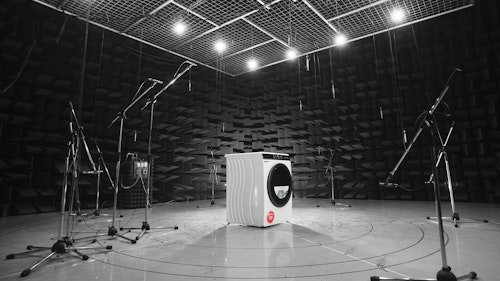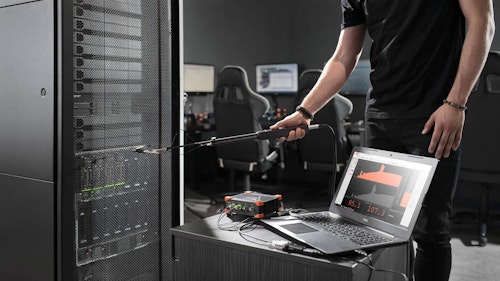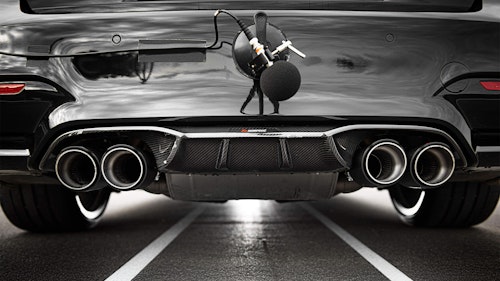SIRIUS® Mini
Portable 4-Channel Sound and Vibration Analyzer
Octave band analysis is an indispensable tool for sound measurement because it gives a close approximation of how the human ear responds. Dewesoft octave band analyzer meets all of the IEC and ANSI specifications for octave filters.
Dewesoft offers flexible data acquisition hardware with an industry-leading 7-year warranty, free lifetime software updates, and free technical support.
True octave filters exactly represent the filter sets defined by the IEC 61260 standards and give the user a real-time response for vivid live visualization of data, crucial for advanced acoustic analysis.
For large channel count systems, Dewesoft provides extremely fast calculations from the frequency domain.
The octave analyzer is perfectly integrated with sound level, sound power, sound intensity, and other modules for advanced sound analysis.
For deep analysis of data Dewesoft provides very narrow band analysis up to 1/24th octave.
Standard frequency weighting curves (A, B, C, D, and Z) can be applied directly in a frequency domain for the analysis of sound.
Block history with linear, peak, exponential averaging or overall calculation is available.
Every Dewesoft data acquisition system is bundled with award-winning DewesoftX data acquisition software. The software is easy to use but very rich and deep in functionality. All software updates are free forever with no hidden licensing or yearly maintenance fees.
Enjoy our industry-leading 7-year warranty. Our data acquisition systems are made in Europe, utilizing only the highest build quality standards. We offer free and customer-focused technical support. Your investment into the Dewesoft solutions is protected for years ahead.
And we're confident you'll love it too! But don't just take our word for it. Get hands-on with a demo unit, completely free of charge. No strings attached, just real data. Reach out to your local Dewesoft team and get your demo unit now!
It includes everything you need for advanced data acquisition and common signal processing — no maintenance fees, no contracts. You buy it, you own it. All future updates? Free forever. And the best part? Analysis seats are unlimited and free. Once the data is recorded, anyone can download our software to review and analyze your data — no license needed.
Dewesoft is 100% owned by employees who believe in what we do — and love doing it. We’re in this with heart, passion, and long-term commitment. What does that mean for you? Our core value — caring for our customers — isn’t going anywhere. We’re here for the next 100 years, protected from outside acquisitions. Your investment in our technology is safe, supported, and future-proof.
At Dewesoft, quality isn't just a promise — it's a core value. Our products are 100% designed, developed, and manufactured in-house, right in the heart of the European Union. From precision machining and PCB manufacturing to final assembly and software development — we do it all ourselves, to the highest ISO standards. We're proud to support local production and take social responsibility seriously.
At Dewesoft, quality is more than just a word — it's a commitment. That's why our products come with an industry-leading 7-year warranty. It's just one more way we protect your investment and give you peace of mind for the long run.
CPB filter is a filter whose bandwidth is a fixed percentage of a centre frequency. The width of the individual filters is defined relative to their position in the range of interest. The higher the centre frequency of the filter, the wider the bandwidth.
The widest octave filter used has a bandwidth of 1 octave. Many subdivisions into smaller bandwidths are often used. The filters are often labeled as “Constant Percentage Bandwidth” filters. A 1/1-octave filter has a bandwidth of close to 70% of its centre frequency. The most popular filters are perhaps those with 1/3-octave bandwidths. One advantage is that this bandwidth at frequencies above 500 Hz corresponds well to the frequency selectivity of the human auditory system. DEWESoft supports up to 1/24-octave bandwidth.
Uses filter sets as in analog octave analyzers. One of the main advantages is that we can really see the dynamic behavior of the input data.
Calculated using FFT as the base and is updated when every FFT is being calculated.
Frequency weighted noise measurements offer standard ways to measure sound, and we use each of these frequency weightings for different types of measurements.
A-weighting is applied to measured sound levels in an effort to account for the relative loudness perceived by the human ear. The human ear is less sensitive to low and high audio frequencies.
B-weighting is the best weighting to use for music listening purposes.
C-weighting is used for high-level noise measurements.
D-weighting was specifically designed for use when measuring high-level aircraft noise in accordance with the IEC 537 measurement standard. The large peak in the D-weighting curve reflects the fact that humans hear random noise differently from pure tones, an effect that is particularly pronounced around 6 kHz.
Z-weighting is linear at all frequencies and it has the same effect on all measured values.
Averaging is used to get more stable results. There are three averaging modes available:
Linear averaging - each FFT counts the same
Exponential averaging - FFT’s become less and less important with time
Peak hold averaging - only maximum results are stored and shown
We've gathered all the answers you're looking for, neatly organized just for you.
An octave band is a frequency band that spans one octave. In this context, an octave can be a factor of 2 or a factor of 100.3. 2/1 = 1200 cents ≈ 100.301. Fractional octave bands such as 1⁄3 or 1⁄12 of an octave are widely used in engineering acoustics.
Octave band analysis is often used in noise control, hearing protection and sometimes in environmental noise issues.
Real-time octave band analyzers are special sound level meters that divide noise into its frequency components. Electronic filter circuits are used to divide the sound or noise into individual frequency bands.
Dewesoft offers flexible octave band analyzers for any sound measurement.
CPB filter is a filter whose bandwidth is a fixed percentage of a center frequency. The width of the individual filters is defined relative to their position in the range of interest. The higher the center frequency of the filter, the wider the bandwidth.
The widest octave filter used has a bandwidth of 1 octave. Many subdivisions into smaller bandwidths are often used. The filters are often labeled as Constant Percentage Bandwidth filters.
A 1/1-octave filter has a bandwidth of close to 70% of its center frequency. The most popular filters are perhaps those with 1/3-octave bandwidths. One advantage is that this bandwidth at frequencies above 500 Hz corresponds well to the frequency selectivity of the human auditory system.
Dewesoft CPB solution supports up to 1/24-octave bandwidth.
A human ear doesn't have an equal "gain" at different frequencies. We will perceive the same level of sound pressure at 1 kHz louder than at 100 Hz. To compensate for this "error", we use frequency weighting curves, which give the same response as the human ear has.
The most commonly known example is frequency weighting in sound level measurement where a specific set of weighting curves known as A, B, C, and D weighting as defined in the IEC 61672 standard.
Unweighed measurements of sound pressure do not correspond to perceived loudness because the human ear is less sensitive at too low and high frequencies. The curves are applied to the measured sound level, by the use of a weighting filter in a sound level meter.
Can't find the answer you're looking for? Our team is happy to answer your questions.
See and browse related and compatible data acquisition products.
Portable 4-Channel Sound and Vibration Analyzer
Modular Data Acquisition (DAQ) System
8-Channel USB Data Acquisition (DAQ) System
Award-Winning Data Acquisition and Digital Signal Processing Software
Sensor adapters for universal amplifiers
IEC/ANSI traceable calibration for the entire measurement chain
See and browse related and compatible testing solutions.

Sound power level measurement solution according to ISO standards

Sound intensity level solution fully compliant with ISO standards

Applied psychoacoustics and sound engineering